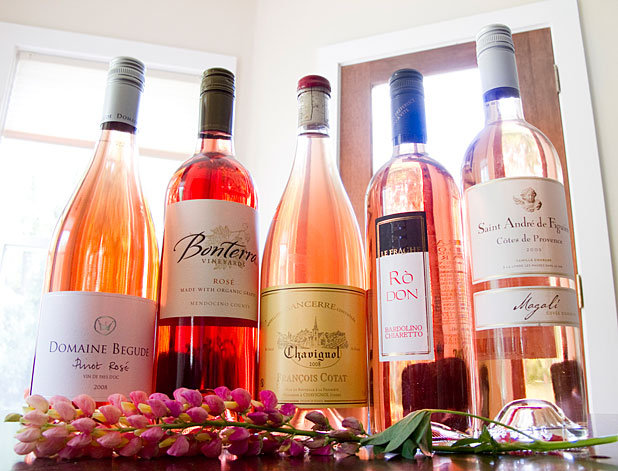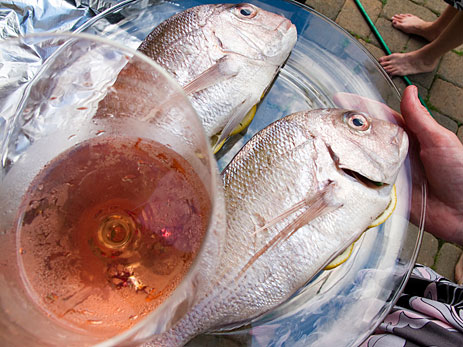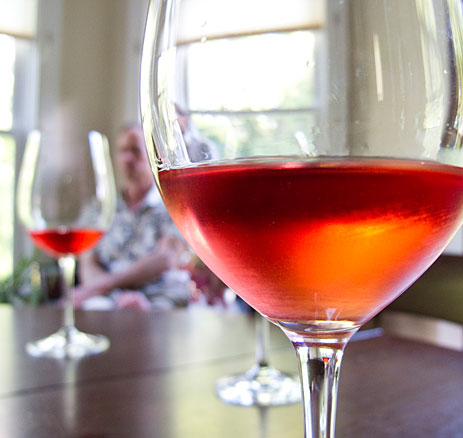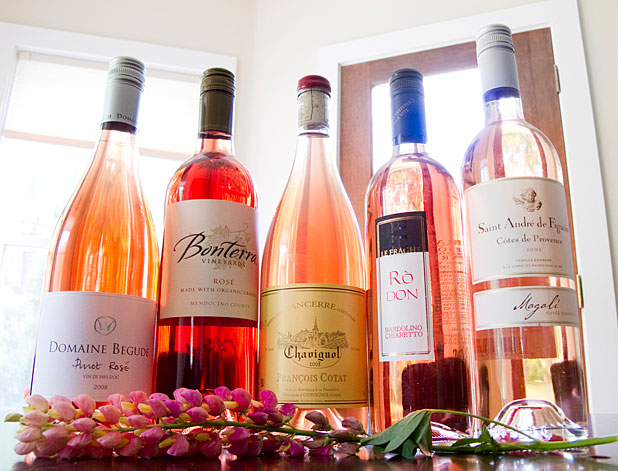 (Jason Houston photos)
(Jason Houston photos)
 When a certain Grist editor who shall remain nameless, suggested I do an organic rosé tasting, I was eager to comply. The weather has been getting warmer, and I had fond memories of a hiking trip in southern France that involved a familial decision to consume crisp, refreshing rosés in lieu of sports drinks. Plus, after my recent organic milk tasting (which generated lots of hate mail in shouty ALL CAPS), a wine tasting sounded as light and fun as pink wine itself.
When a certain Grist editor who shall remain nameless, suggested I do an organic rosé tasting, I was eager to comply. The weather has been getting warmer, and I had fond memories of a hiking trip in southern France that involved a familial decision to consume crisp, refreshing rosés in lieu of sports drinks. Plus, after my recent organic milk tasting (which generated lots of hate mail in shouty ALL CAPS), a wine tasting sounded as light and fun as pink wine itself.
But there are more serious, compelling reasons to drink organic wines: conventional grapes may be blasted with an unholy trinity of pesticides, herbicides, and fungicides that are readily soaked up through their thin skins. Imported grapes make the Environmental Working Group’s “Dirty Dozen List.” A 2008 Pesticide Action Network study on European wines showed that pesticide residues do indeed turn up in wines. (Whether or not these levels will harm consumers remains much debated. I suppose that depends in part on how much of a wino oenophile you are. Then there’s the matter of the farmworkers who have to handle the chemicals, for the less selfish among you.)
Rosés have an unfairly bad rap. Wine reform advocate Alice Feiring told me by email, “There have always been excellent rosés, but there has been a lot of plonk, and the category suffered and suffers still because people associate pink with white-zinfandel sweet crap. Recently the EU tried to really dumb down the category by allowing a blending of white and red to make rosé. That idea went over like a leaden dumpling. But winemakers have always made some for themselves — refreshing, food friendly. Hell, even Long Island makes credible rosé.”
To find out if pink-and-green rosés taste good, I served a thirsty tasting panel an assortment of pink wine before and during a dinner of CSA-fresh vegetables and grilled dayboat fish. I purposely put together a panel of wine amateurs, which may be a positive new trend in wine circles. Let’s face it, nothing ruins a cocktail hour faster than a wine bore.
Our non-expert results follow:
La Fraghe Ro Don Bardolino Chiaretto Rose 2009
Price: $13.99
Grapes used: Corvina and Rondinella
Green ethos: How hard could it be to swing by the wine store and pick up a few environmentally principled bottles of pink vino? Harder than you’d think. As it turns out, I can’t easily buy wine from out of state online, so I turned to my neighborhood wine seller to get some for me. One particularly sweet guy, Andy, assured me that this wine was organic or sustainable in some way, even if there were no bragging rights on the label because small growers often skip expensive certifications. But I knew that was not going to fly for you, dear crankypants readers. Despite copious Web research, a dozen phone calls to importers, reps, and wine makers (sent in Italian via Google translator – “please I would most be liking to your wines about ask you”), neither I nor the now-quite-apologetic Andy could get any solid information verifying this wine’s alleged green vibe. But waste is wrong in an environmentally precarious world, and this wine needed to be drunk, so we drank it, savoring the mystique about its alleged green past.
Tasting notes: Tasters noted that the color of this wine was “very pale” and “blushier” than the others. Its nose was deemed “delicate” and “more like a rose than fruit.” One taster got “papaya” at first sip, which made a another taster sarcastically predict that “someone is going to get passion fruit.” (Nobody did.) Overall, the tasters were at odds to whether this wine’s delicacy was a good thing: one taster deemed the wine to be “girly,” while another enthused that it was a “hot afternoon wine . . . a drinkin’ wine! The PBR of rosés!”
Rank: #3
Francois Cotat Sancerre Chavignol Rosé 2008
Price: $33.99 (so much for the rosé’s cheap-wine reputation)
Grapes used: Gamay, Pinot Noir
Green ethos: 100% organic domaine; vines are tended and harvested by hand. Wine is made using traditional techniques – this is a natural wine (“Natural” actually means something substantive in the wine world, unlike the food world; as to what it means, read Tom Philpott’s nerdy screed on the topic.)
Tasting notes: Dark peach in color. Scent comments: “syrupy” and “like late summer fruit” and “peach syrup.” First sip had tasters abuzz: “tart!” and another tasted parsley. This rosé was definitely more robust than the others. Tasters described its “strong flavor” and super-full” mouth-feel, which one taster described as “thick.” No one disagreed that this wine was the most complex. In the end, though, the tasters decided that it was actually “too heavy for a rosé” and as having a quality that “stays with you — not a happy thing.” On the other hand, it was noted by more than one taster that this was the best rosé to pair with food. Most interestingly, this wine launched a conversation about the true nature of rosés and their sole purpose, which one taster argued was to “ride’em hard and put them away wet.” Additional note: This wine may have in fact been a victim of the “Skippy Effect,” a phrase I learned from a Cooks Illustrated editor who explained to me that tasters might have a preference for certain foods, even crappy ones, based on nostalgia. Hence, in the face of an organic artisan nut butter, a taster prefers the ersatz, Cristco-y taste of Skippy. (Or, here, a more effete, more industrial pink wine over an artisanal one.) It’s also worth noting that Alice Feiring (see below) told me that she thought that this wine was “quite good.”
Rank: #4
 Bonterra Vineyards Mendocino County Rose 2008
Bonterra Vineyards Mendocino County Rose 2008
Price: $12.99
Grapes used: Sangiovese, Zinfandel, and Grenache
Green ethos: Vineyards have been organic since 1987. Bonterra’s organic philosophy is to “let nothing come between the vines and land upon which they grow. Everything in balance.”
Tasting notes: The color of this wine made tasters downright giddy. Several tasters chanted “Pink, pink!” while a detractor noted that it was actually “kinda salmony or orangey-pink.” The sniff test revealed berry and strawberry notes, while two other tasters thought its nose was floral. One taster thought he smelled strawberries, but then confessed that he may have picked “a pink fruit by association.” At first sip, someone tasted citrus, while another noted a “nice tart finish … on the edge of being acidic but not quite. Balanced.” Another happy taster who didn’t want to employ the sip n’ spit method quipped, “I need nothing to balance anything, just give me a straw!”
Rank: #2
Domaine Begude Pinot Rosé 2008
Price: $14.99
Grapes used: Pinot Noir
Green ethos: Governing philosophy in the vineyard is “to promote a healthy, sustainable environment, giving us grapes of the very highest natural quality.” Hence, this vineyard fertilizes with organic sheep/cow manure; weeds mechanically rather than chemically; encourages the growth of green manures. Biodynamic approaches include paying careful attention to the lunar calendar, especially at planting, pruning, and harvest.
Tasting notes: Colorwise, this wine was a little more salmon-hued than the others (or darker gray, according to a colorblind taster). The nose was complex, with “tarty fruits” (you know, those louche fruits that dress skimpily and hang out at the corner bar). Overall, sippers were delighted with this rosé, and one lady declared that it “makes me wanna get my drink on!” Another taster thought he detected the taste of salami — and explained that this was a good thing, because it was “delicious and meaty.” Other praise included “smooth” and “pretty dry” with “real complexity.” Comment that perhaps hinted of a substance-abuse problem: “I would drink this nonstop all day!” The biggest compliment came when I tried to take this wine away from a taster who snatched the glass from my hands and slurped up the remaining mouthful.
Rank: #1
Saint Andre de Figuiere Cotes de Provence Rosé 2009
Price: $13
Grapes used: Cinsault, Syrah, Cabernet, Grenache
Green ethos: Again, I was very excited when yet another wine buyer (John) told me that he’d procured a cheap organic rosé for me. But once the bottle was in hand, he’d learned that Saint André de Figuière estate wines come from land that has been farmed organically for more than a quarter century, but that this particular rosé is from the company’s more affordable signature series, which sources wines from nearby “neighborhood vineyards.” Ever hopeful that these neighborhood wines were somehow also sustainably cultivated, I made several attempts to contact growers, importers, and reps. Result: N’est-ce pas que personne ne me rappeller! (Go ahead, run that through your Google translator and see just how good my French is). I kept it in the tasting because … well, because my Grist editor told me to, wanting me to get smacked around like I did with last month’s milk-off.
Tasting notes: This “very pale” and orangey rosé fulfilled earlier predictions at first sniff — “There’s the passion fruit!” Another said its bouquet was comprised of “tropical flowers.” Once swished across the palette, though, this wine disappointed. One lady wistfully noted that it was “like white wine.” Another gargled it and said that there was “something syrupy going on” while someone else countered with “something chemical.” Strangest comments: two tasters said they tasted parsley. Most ambiguous comment: “Tippy-toe light.”
Rank: #5
The bottom line
This panel was a little like Goldilocks: This rosé is toooooo light, this rosé is toooooo strong . . . and this rosé is just right! Happily, the Domaine Begude that came out on top is both affordable and biodynamically produced.
A few tips before you go on your own rosé hunt: Read labels and learn the difference between an organic wine and one simply made with organically grown grapes, but recognize that you might have to do a legwork to find out if your wine is truly sustainable. Make calls, ask around, use the web and learn a second language. Also, know that finding a good rosé might take a little extra work.
Lastly, if you’re going to do your own tasting, serve food, have fun, drink responsibly and heed the following tips.
Okay, that wasn’t lastly. A note on packaging: I couldn’t find any rosés made with local grapes, thus my Yeti-like carbon footprint. I also couldn’t find any in Tetrapak. All the bottles from this tasting were glass and promptly recycled. (Except in many states, like Massachusetts, wine bottles are exempt from so-called Bottle Bills.) For more info on the carbon footprint of wine, and how to shrink yours, read a real expert on the topic.


